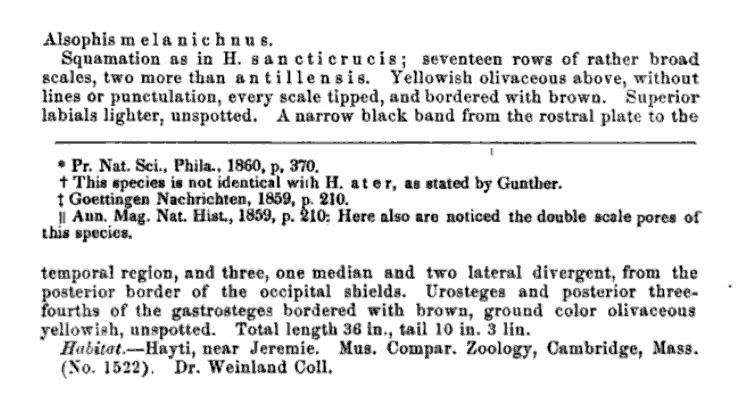|
|
Post by Melanie on Apr 15, 2008 23:53:34 GMT
Alsophis melanichnus
last collected in 1910
|
|
|
|
Post by amongthylacines on Apr 16, 2008 10:21:00 GMT
The Dominican Republic faces multiple threats to biodiversity. A list of native species of amphibians and reptiles (excluding sea turtles) is presented. Some may have become extinct recently, substantial populations of others have been extirpated, some have greatly reduced numbers, and others appear to be rare or have restricted ranges. Most of the 13 taxa listed are relatively large, vulnerable to human exploitation or introduced predators, and/or have limited distributions and specific habitat requirements. To be listed, evidence must exist that: (1) populations are dwindling, (2) the range is shrinking, or (3) a species must be vulnerable to exploitation and historically rare. Two iguanas (Cyclura cornuta, C. ricordii), two turtles (Trachemys decorata, T. stejnegeri vicina), and one crocodilian (Crocodylus acutus) have been exploited extensively and have long been recognized as threatened or endangered. The ranges of Cyclura ricordii and T. decorata are very localized and the previously widespread ranges of the others have shrunk or become fragmented. A toad (Bufo fluviaticus), a large galliwasp (Celestus anelpistus), and a snake (Alsophis melanichnus) have not been collected recently. Only a few specimens of another galliwasp (C. carraui) and a dwarf gecko (Sphaerodactylus cochranae) have been taken recently. In addition, extensive portions of the habitats of these species have been severely altered. Three other snakes (Alsophis anomalus, Ialtris agyrtes, I. dorsalis) are rare and may never have been common. Their size and habits render them vulnerable to predation by the introduced mongoose and to decimation by humans who fear and dislike them.
|
|
|
|
Post by amongthylacines on Apr 16, 2008 10:41:15 GMT
Alsophis melanichnus (englischer Trivialname: Hispaniola racer) ist eine vermutlich ausgestorbene Schlangenart aus der Familie der Nattern. Sie war auf Haiti und in der Dominikanischen Republik heimisch.
Beschreibung
Alsophis melanichnus erreichte eine Länge von 63 Zentimetern. Der Rücken war einheitlich tief olivgrün. Ein weißer Seitenstreifen verlief vom Nacken bis zur Körpermitte. Am Kinn waren einige weiße Tupfen zu erkennen. Am Bauch war das Olivgrün heller als am Rücken. Die meisten Bauchschuppen hatten schmale helle Ränder. Die Lippen waren hell.
Lebensweise
Über die Lebensweise von Alsophis melanichnus ist kaum etwas bekannt. Sie war tagaktiv und jagte ihre Beute am Boden.
Aussterben
Alsophis melanichnus ist nur von wenigen Museumsexemplaren bekannt. Die Art wurde zuletzt 1910 gesammelt. Die Gründe ihres Verschwindens sind nicht hinreichend erforscht, aber vermutlich ist die Nachstellung durch eingeführte Mungos eine der Hauptursachen.
(I'm no German (nor English) but I shall try to translate it for you amigo's)
Alosophis melanichnus (Hispaniola racer) is a probably extinct snake from the family Colubridae. It was endemic on Haiti and the Dominican Republic.
Description
Alophis melanichnus reached a length of 63 cm. The back was deep olivegreen. A white stripe on the sides ran from the neck to the middle-part of the body. On their chin were some white spots. The olivegreen on the belly was paler than on their back. Most of their scales had little light edges. The lips were pale also.
Behavior
Almost nothing is known about the behavior of Alophis melanichus. It was diurnal and terrestrial.
Extinction
Alophis melanichus is known from just a few museum specimens. The species was last collected in 1910. The causes of their extinction are not known but is is assumed that it could be the introduction of the mongoose.
|
|
|
|
Post by Melanie on Apr 16, 2008 15:22:20 GMT
well, this was my German Wikipedia text. The translation is very good. Thank you very much for your effort. Some more on this species can be find in this publication Doris Mable Cochran: The herpetology of Hispaniola, 1941 or here: *Albert Schwartz & Robert W. Henderson: ''Amphibians and reptiles of the West Indies: descriptions, distributions, and natural history''. – University of Florida Press, Gainesville, 1991. ISBN 9780813010496 *Robert W. Henderson ''Consequences of Predator Introductions and Habitat Destruction on Amphibians and Reptiles in the Post-Columbus West Indies''. – Caribbean Journal of Science, Vol. 28, No 1-2, 1-10, 1992. academic.uprm.edu/publications/cjs/VOL28/P001-010.PDF *Warren S. T. Hays & Sheila Conant: ''Biology and Impacts of Pacific Island Invasive Species. 1. A Worldwide Review of Effects of the Small Indian Mongoose, Herpestes javanicus (Carnivora: Herpestidae)'' Pacific Science (2007), vol. 61, no. 1:3–16. University of Hawai‘i Press, 2007 www.bioone.org/archive/1534-6188/61/1/pdf/i1534-6188-61-1-3.pdf |
|
|
|
Post by amongthylacines on Apr 16, 2008 15:40:15 GMT
Oh wicked it was you?
High five !
Well I never had Deutch at school but when you grow up with German Westerns & Horror like me it ain't too hard, I guess.
(It took me years before I knew John Wayne, Clint Eastwood and Christopher Lee (Dracula) was an American ?)
|
|
|
|
Post by another specialist on Sept 1, 2008 18:14:59 GMT
 Proceedings of the Academy of Natural Sciences of Philadelphia By Academy of Natural Sciences of Philadelphia, BioOne (Organization), Herman Strecker |
|
|
|
Post by Sebbe on Dec 14, 2016 19:20:43 GMT
|
|